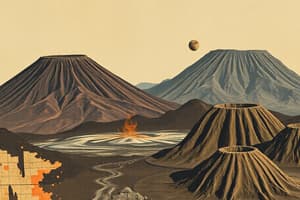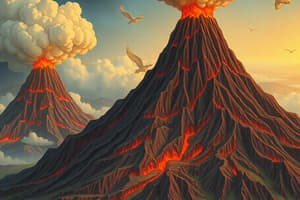Podcast
Questions and Answers
What is primarily responsible for the explosive nature of a volcanic eruption?
What is primarily responsible for the explosive nature of a volcanic eruption?
- The shape of the volcano
- The temperature of the magma
- The presence of dissolved gases in the magma (correct)
- The size of the volcano
Which type of volcano is characterized by broad, gently sloping structures primarily built from basaltic lava flows?
Which type of volcano is characterized by broad, gently sloping structures primarily built from basaltic lava flows?
- Cinder cone
- Supervolcano
- Shield volcano (correct)
- Composite volcano
What is the major risk associated with pyroclastic flows?
What is the major risk associated with pyroclastic flows?
- They are slow-moving and predictable
- They consist mainly of solidified lava
- They can cause contamination of water sources
- They are fast-moving and can cause rapid destruction (correct)
Which factor does NOT influence the type of volcanic eruption?
Which factor does NOT influence the type of volcanic eruption?
What are lahars primarily composed of?
What are lahars primarily composed of?
Which monitoring technique is used to observe ground deformation in volcanoes?
Which monitoring technique is used to observe ground deformation in volcanoes?
Subduction zones are particularly known for what type of geological activity?
Subduction zones are particularly known for what type of geological activity?
What is a supervolcano capable of creating?
What is a supervolcano capable of creating?
Flashcards
What are volcanoes?
What are volcanoes?
Openings in the Earth's crust where molten rock (magma), ash, and gases erupt. They form when magma rises to the surface, often associated with tectonic plate boundaries.
What are subduction zones?
What are subduction zones?
Areas where one tectonic plate slides beneath another, creating a lot of volcanic activity.
What influences a volcano's eruption?
What influences a volcano's eruption?
The composition, temperature, and thickness of magma. A thicker magma creates more explosive eruptions.
What is a shield volcano?
What is a shield volcano?
Signup and view all the flashcards
What are pyroclastic flows?
What are pyroclastic flows?
Signup and view all the flashcards
What are lahars?
What are lahars?
Signup and view all the flashcards
How do scientists monitor volcanoes?
How do scientists monitor volcanoes?
Signup and view all the flashcards
Is volcanic activity predictable?
Is volcanic activity predictable?
Signup and view all the flashcards
Study Notes
Definition and Formation
- Volcanoes are openings in the Earth's crust through which molten rock (magma), ash, and gases erupt.
- Volcanoes form when magma from deep within the Earth rises to the surface.
- This process is often associated with tectonic plate boundaries, where plates collide, separate, or slide past each other.
- Subduction zones, where one plate dives beneath another, are particularly active volcano-forming regions.
- Magma composition, temperature, and viscosity significantly influence a volcano's eruptive style.
- The presence of dissolved gases in magma contributes to explosive eruptions.
- Some volcanoes are formed by the accumulation of solidified lava flows, while others result from pyroclastic materials like ash and bombs.
Types of Volcanoes
- Shield volcanoes are broad, gently sloping structures built primarily from fluid basaltic lava flows.
- Cinder cones are small, steep-sided volcanoes built from ejected fragments of lava called tephra.
- Composite volcanoes, also known as stratovolcanoes, are large, cone-shaped volcanoes constructed from alternating layers of lava flows and pyroclastic materials.
Eruption Types
- Effusive eruptions involve the relatively quiet outpouring of lava.
- Explosive eruptions are characterized by the violent ejection of pyroclastic materials, ash, and gas.
- The type of eruption depends on several factors: magma viscosity, gas content, and pressure.
- Supervolcanoes are large volcanoes capable of producing extremely powerful eruptions, creating large volcanic calderas.
Volcanic Hazards
- Lava flows can destroy property and threaten lives.
- Pyroclastic flows are fast-moving currents of hot gas and volcanic fragments.
- Ash falls can bury landscapes and contaminate water sources.
- Lahars are mudflows formed from a mixture of volcanic debris and water.
- Volcanic gases, including sulfur dioxide and carbon dioxide, can be harmful to human health and the environment.
- Volcanic earthquakes and tremors frequently accompany eruptions and can cause widespread damage.
Monitoring and Prediction
- Scientists monitor volcanoes using a variety of techniques, including seismic monitoring, gas measurements, ground deformation, and thermal imaging.
- Volcanic activity is not always easily predicted, with some eruptions occurring with little to no warning.
- Monitoring data helps scientists assess the potential hazards associated with a volcano and inform evacuation plans if necessary.
- Understanding the history of volcanic eruptions within a region is crucial for assessing future risks.
Global Distribution
- Volcanoes are not uniformly distributed across the globe.
- Most volcanoes are located along tectonic plate boundaries, particularly at subduction zones.
- Specific regions, like the Pacific Ring of Fire, have high concentrations of active volcanoes.
- Volcanic activity can also occur along divergent plate boundaries, like mid-ocean ridges.
Studying That Suits You
Use AI to generate personalized quizzes and flashcards to suit your learning preferences.




